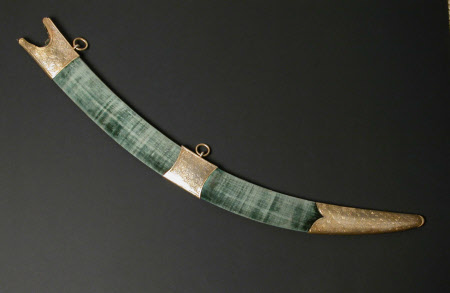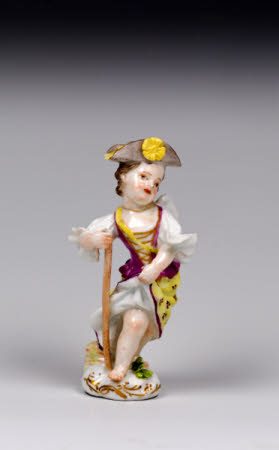Scabbard
Category
Arms and armour
Date
1782 - 1799
Materials
wood, silk, and silver gilt
Measurements
775 mm (Length)
Place of origin
Mysuru (Mysore)
Order this imageCollection
Powis Castle and Garden, Powys
NT 1185192
Summary
Curved scabbard covered in dark green velvet, made between 1782 and 1799, in Mysuru (formerly called Mysore), India. The locket, chape and sword belt-mount are of gilt silver, chased with tiger-stripe cartouches containing florets on a ring-matted ground. This scabbard is paired with sword NT 1180590. Both are associated with Tipu Sultan (1750-99), who ruled Mysuru from 1782-99, where he built a sophisticated court around his palace at Srirangapatna (formerly known as Seringapatam).
Full description
A letter to Edward Clive (1754-1839), then Governor of Madras (1798-1803), may refer to this scabbard, shedding light on how it reached Powis Castle. Allan Grant, a captain at the Siege of Srirangapatna, wrote on 30th November 1799: ‘Understanding from Genl. Floyd that Swords or Firelocks made in the Arsenal of this place & found in the Palace of the late Tippoo Sultaun, are consider'd curious, & much sought after at Madras. I have taken the liberty of sending to your Lordship by Lieutt. Sydenham a small assortment of these Articles, which appear to me of equal workmanship with any that have been found here.’ He notes: ‘I have alter'd the mounting of the Sword, as it would not have been possible for your Lordship to have worn it with the original Scabbard & I have preferr'd covering it with Green Velvet instead of Red to make it Correspond with the Facings worn by the Shropshire Militia in case your Lordship should at any time be disposed to bear it.’ [1] This scabbard appears to have been altered as described here, suggesting that this could be the sword referenced in Grant’s letter. As Colonel of the Shropshire Militia, Clive would have been mounted and the suspension rings now attached to the scabbard would have been essential to enable attachment to the standard pattern sword belt for mounted officers. [2] Research Note on Provenance Tipu Sultan spent much of his reign engaged in the defence of Mysuru against encroachment by the British East India Company. In 1798, a renewed British campaign provoked the Fourth Anglo-Mysore War. On 4th May 1799, during the Siege of Srirangapatna, Tipu was killed. In the immediate aftermath, the British army looted the town. According to Colonel Arthur Wellesley, later the Duke of Wellington, ‘Scarcely a house in the town was left unplundered, and I understand that in camp jewels of the greatest value, bars of gold etc etc have been offered for sale in the bazaars of the army by our soldiers, sepoys and followers. I came in to take command of the army on the morning of the 5th and with the greatest exertion, by hanging, flogging etc etc in the course of that day I restored order…’ [Dalrymple, p. 351]. The resumption of control by the higher ranks of the army enabled the work of the prize committee to begin. Prize committees were responsible for ‘collecting, inventorying and disposing of booty seized from the enemy and for … seeking to establish combatants’ entitlement to prize' [Finn, p.17]. They were intended to prevent the kind of undisciplined plunder which Wellesley reported in the aftermath of Tipu’s defeat at Srirangapatna. More than 1,000 commissioned officers took their allotted share in the captured property, which they kept, exchanged or sold to others. High value, or high-profile items, were excluded from the prize committee’s remit, and given to senior civil and military personnel, as well as the British royal family. Not all articles were genuine: tenuous or spurious attributions to Tipu Sultan have been identified in objects which were brought to Britain. Recent work on a sword at the Wallace Collection [OA1402] has shown that an inscription on the blade suggesting personal ownership by Tipu was added after his death in 1799. [1] British Library, IOR/L/MIL/5/159: Prize and Batta Rolls: Seringapatam 1799 (1800) [2] K Hazzard, personal communication, 25/2/22.
Provenance
Purchased by the National Trust from John George Herbert, 8th Earl of Powis and the Powis Estate Trustees in June 2010.
References
2019 Dalrymple: W Dalrymple, The Anarchy: The Relentless Rise of the East India Company, Bloomsbury 2019 2018 Finn: Margot Finn, ‘Material Turns in British History I: Loot’, Transactions of the Royal Historical Society, Vol. 28, December 2018 2004 Satyanarayana: A Satyanarayana ‘Review: The Mysore Sultans. State and Diplomacy under Tipu Sultan: Documents and Essays by Irfan Habib’ Economic and Political Weekly 39 24 (2004) 1995 Brittlebank: K Brittlebank, ‘Sakti and Barakat: The Power of Tipu’s Tiger. An Examination of the Tiger Emblem of Tipu Sultan of Mysore’, Modern Asian Studies 29 2 (1995) Archer, Rowell and Skelton 1987 Mildred Archer, Christopher Rowell, and Robert Skelton, Treasures from India: The Clive Collection at Powis Castle, London, 1987

